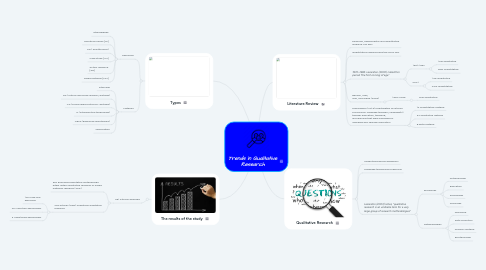
1. Types
1.1. Approach
1.1.1. Ethnography
1.1.2. Narrative inquiry [NI]
1.1.3. AR ( practitioners)
1.1.4. Case study [CS]
1.1.5. Action research [AR]
1.1.6. Mixed methods [MM]
1.2. Methods
1.2.1. Interview
1.2.2. DA (Critical discourse analysis, writings)
1.2.3. CA (Transcribed protocols- writings)
1.2.4. IT (Introspective techniques)
1.2.5. ORIQ (Response questionare)
1.2.6. Observation
2. The results of the study
2.1. 781 Articles analyzed
2.1.1. 326 Employed qualitative methodology either within qualitative research or mixed methods research (42%)
2.1.2. 226 Articles (29%) undertook qualitative research
2.1.2.1. 176 Used one approach
2.1.2.2. 45 Used two approaches
2.1.2.3. 5 Used three approaches
3. Qualitative Research
3.1. Understand human behaviors
3.2. Language teaching and learning
3.3. Lazaraton (2003) notes, “qualitative research is an umbrella term for a very large group of research methodologies”
3.3.1. Disciplines
3.3.1.1. Anthropology
3.3.1.2. Education
3.3.1.3. Psychology
3.3.1.4. Sociology
3.3.2. Methodologies
3.3.2.1. Approach
3.3.2.2. Data collection
3.3.2.3. Analysis method
3.3.2.4. Epistemology
4. Literature Review
4.1. Empirical, experimental and quantitative research 70s 80s
4.2. Quantitative research was the norm 90s
4.3. 1970–1985. Lazaraton (2000) called this period “the first coming of age”
4.3.1. 1991–1997
4.3.1.1. 10% Qualitative
4.3.1.2. 90% Quantitative
4.3.2. 2001
4.3.2.1. 14% Qualitative
4.3.2.2. 40% Quantitative
4.4. Benson, Chik, Gao, and Wang (2009)
4.4.1. 1997–2006
4.4.1.1. 22% Qualitative
4.5. Kleinsaasser (2013) investigated 79 articles focusing on language teachers, language(s) teacher education, teaching, and learning that were published in Teaching and Teacher Education
4.5.1. 12 Quantitative method
4.5.2. 54 Qualitative method
4.5.3. 8 Both method

